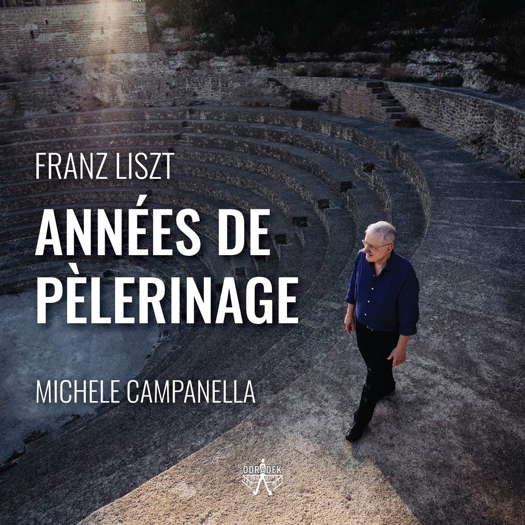 DISCUSSION: John Dante Prevedini leads a discussion about Classical Music and Politics, including contributions from Béla Hartmann and James Ross.
DISCUSSION: John Dante Prevedini leads a discussion about Classical Music and Politics, including contributions from Béla Hartmann and James Ross.

Liszt the Pilgrim
Michele Campanella's recording of Liszt's 'Années de pèlerinage', reviewed by GIUSEPPE PENNISI
'... a virtuoso rendering with a very personal touch.'
This set of three CDs published by Odradek Records is a new addition to a long list of recordings of these three suites for solo piano by Franz Liszt. There are some forty albums, starting from hard-to-find records by Claudio Arrau in the late 1920s and by Béla Bartók in 1936 to a recent set by the young French Hungarian pianist Suzana Bartal. In short, many masters of the keyboard felt the challenge to perform and record this Liszt masterpiece.
Années de pèlerinage (S 160, S 161 and S 163) is much derived from his earlier work, Album d'un voyageur, his first major published piano cycle, which was composed between 1835 and 1838 and published in 1842. Années de pèlerinage is widely considered as the masterwork and summation of Liszt's musical style. The third volume is notable as an example of his later style. Composed well after the first two volumes, it displays less virtuosity and more harmonic experimentation.
The title Années de pèlerinage refers to Goethe's famous novel of self-realization, Wilhelm Meister's Apprenticeship, and especially its sequel, Wilhelm Meister's Journeyman Years - the original title Wilhelm Meisters Wanderjahre meant Years of Wandering or Years of Pilgrimage, the latter being used for its first French translation. Liszt clearly places these compositions in line with the Romantic literature of his time, prefacing most pieces with a literary passage from writers such as Schiller, Byron or Senancour. In an introduction to the entire work, he wrote:
I have recently travelled to many new countries, through different settings and places consecrated by history and poetry. I have felt that the phenomena of nature and their attendant sights did not pass before my eyes as pointless images. They stirred deep emotions in my soul, and established between us a vague but immediate relationship, an undefined but real rapport, an inexplicable but undeniable communication. I have tried to portray in music a few of my strongest sensations and most lively impressions.
This is a quintessential romantic declaration. In the book with the three CDs, Michele Campanella defines the point of equilibrium reached by Liszt in the eighteen fifties. The virtuoso sound and the search for the extreme limits of piano technique brought by him (and by Paganini) to unheard-of regions. This is not cancelled but, after his experience with opera - mostly in Paris, directed to search for the vocal magniloquence of the piano sound.
This is the thread of Campanella's reading of the three suites. The first refers to Lizst's travels in Switzerland. It starts with a homage to William Tell, the Swiss national hero: a very effective C major introduction.
Listen — Liszt: Chapelle de Guillaume Tell (Années de pèlerinage, S 160)
(CD1 track 1, 0:03-0:55) © 2020 Odradek Records LLC:
This is followed by a peaceful vision of Lake Wallenstadt in A flat major where Campanella makes us remember a passage from Lord Byron's Childe Harold's Pilgrimage (Canto III, stanza 68).
Listen — Liszt: Au lac de Wallenstadt (Années de pèlerinage, S 160)
(CD1 track 2, 0:00-0:59) © 2020 Odradek Records LLC:
After wandering in the beautiful Swiss landscape, the suite becomes tender and engrossing in the Eglogue in A flat major, in the home sickness in E minor and in the nocturnal sounds of the bells of Geneva.
Listen — Liszt: Les cloches de Genève (Années de pèlerinage, S 160)
(CD1 track 9, 0:00-0:58) © 2020 Odradek Records LLC:
The other two suites concern travelling in Italy. Not Le Grand Tour to see ancient Roman ruins but rather reflections on ceremonies (ie a wedding), on poetry (eg by Salvator Rosa, Petrarch, on prayers) as well as on sights - especially Villa d'Este in Tivoli.
Here Michele Campanella unveils his very Italian nature. Or better, he is a Neapolitan in spirit, by family and by schooling. He himself states that he tends toward pessimism but that irony saves him.
The pessimism is mostly in Suite No 3: the Villa d'Este cypresses in G and E minor, the funeral march in F minor and the prayers. Pessimism is enmeshed with empathy since the very start of the suite, the prayer to the Guardian Angels in E major.
Listen — Liszt: Angelus! Prière aux anges gardiens (Années de pèlerinage, S 163)
(CD3 track 1, 0:01-0:56) © 2020 Odradek Records LLC:
There is irony, nearly Neapolitan irony in the reading of Petrarch's Sonnets in D minor, E minor and A flat, in the look at Raphael's painting of the Marriage of the Virgin in E major as well in the Salvator Rosa' song in A minor.
Listen — Liszt: Canzonetta del Salvator Rosa (Années de pèlerinage, S 161)
(CD2 track 3, 2:10-2:57) © 2020 Odradek Records LLC:
In short, this is a virtuoso rendering with a very personal touch.
Copyright © 16 November 2020
Giuseppe Pennisi,
Rome, Italy

CD INFO - LISZT: ANNÉES DE PÈLERINAGE - MICHELE CAMPANELLA



